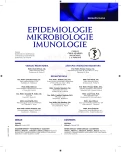A case of tuberculous meningitis associated with persistently reduced CD4+ T lymphocyte counts
Authors:
M. Holub 1,2; O. Beran 1,2; O. Džupová 3; H. Rozsypal 1,2
Authors‘ workplace:
Klinika infekčních a tropických nemocí, 1. LF UK v Praze a Nemocnice Na Bulovce, Praha
1; Klinika infekčních nemocí, 1. LF UK v Praze a Ústřední vojenská nemocnice – vojenská fakultní nemocnice, Praha
2; Klinika infekčních nemocí, 3. LF UK v Praze a Nemocnice Na Bulovce, Praha
3
Published in:
Epidemiol. Mikrobiol. Imunol. 64, 2015, č. 1, s. 20-23
Category:
Review articles, original papers, case report
Overview
A case history is presented of a 35-year-old man admitted to the hospital with tuberculous meningitis complicated by caseous necrosis of cervical lymph nodes and thrombosis of the left jugular vein. Another complication, malignant brain edema, appeared more than one year after discharge from hospital and was managed at the neurosurgery department. The most probable cause was a post-inflammatory obstruction of the cerebrospinal fluid pathways. A challenging finding, observed repeatedly while in hospital and at follow ups after discharge, was medium significant CD4+ T cell lymphopenia, with the lowest CD4+ T cell count of 308 cells/μl of peripheral blood. For this reason, the patient was screened several times for anti-HIV antibodies, but always with a negative result. Active tuberculous infection was considered as another possible reason behind persistent CD4+ T cell lymphopenia. However, imaging and laboratory analyses were not suggestive of tuberculosis. The patient is currently in good condition and his CD4+ T lymphocyte counts returned to normal at seven years of follow-up. It is underlined that patients after tuberculous meningitis need a long-term follow-up.
KEYWORDS:
tuberculous meningitis – complications – immunodeficiency – CD4+ T cells – follow-up
Sources
1. Holčíková A. Tuberkulóza. In Beneš J. Infekční lékařství. Praha: Galén, 2009, s. 277–284.
2. Tuberkulóza a respirační nemoci 2012. Praha: ÚZIS, 2012.
3. Fitzgerald DW, Sterling TR, Haas DW. Mycobacterium tuberculosis. In Mandell GL, Bennett JE, Dolin E. Principles and practice of infectious diseases. Philadelphia: Churchill Livingstone, 2010, s. 3129–3163.
4. Malphettes M, Gérard L, Carmagnat M et al. Late-onset combined immune deficiency: a subset of common variable immunodeficiency with severe T cell defect. Clin Infect Dis, 2009;49(9):1329–1338.
5. Illei GG, Yarboro CH, Kuroiwa T et al. Long-term effects of combination treatment with fludarabine and low-dose pulse cyclophosphamide in patients with lupus nephritis. Rheumatology (Oxford), 2007;46(6):952–956.
6. Zonios DI, Falloon J, Bennett JE et al. Idiopathic lymphocytopenia: natural history and prognostic factors. Blood, 2008;112(2):287–294.
7. Thoden J, Venhoff N, Daskalakis M et al. Disseminated tuberculosis in a patient with idiopathic CD4+ lymphocytopenia. Rheumatology (Oxford), 2009;48(10):1329–1330.
8. Prasad K, Volmink J, Menon GR. Steroids for treating tuberculous meningitis. Cochrane Database Syst Rev, 2000;(3):CD002244.
9. Jones BE, Oo MM, Taikwel EK et al. CD4 cell counts in human immunodeficiency virus-negative patients with tuberculosis. Clin Infect Dis, 1997;24(5):988–991.
10. Turett GS, Telzak EE. Normalization of CD4+ T-lymphocyte depletion in patients without HIV infection treated for tuberculosis. Chest, 1994;105(5):1335–1337.
11. Davoudi S, Rasoolinegad M, Younesian M, et al. CD4+ cell counts in patients with different clinical manifestations of tuberculosis. Braz J Infect Dis, 2008;12(6):483–486.
12. Džupová O, Holub M, Roubková H, Příhodová J. Tuberkulózní meningitida: kazuistika ojedinělého případu v České republice v roce 2003. Čes a slov Neurol Neurochir, 2005;68(6):406–411.
13. Kabelitz D, Hinz T, Dobmeyer T et al. Clonal expansion of Vgamma3/Vdelta3-expressing gammadelta T cells in an HIV-1/2-negative patient with CD4 T-cell deficiency. Br J Haematol, 1997;96(2):266–271.
14. Dye C, Scheele S, Dolin P, Pathania V, Raviglione MC. Consensus statement. Global burden of tuberculosis: estimated incidence, prevalence, and mortality by country. WHO Global Surveillance and Monitoring Project. JAMA, 1999;282(7):677–686.
15. Toossi Z. Virological and immunological impact of tuberculosis on human immunodeficiency virus type 1 disease. J Infect Dis, 2003;188(8):1146–1155.
Labels
Hygiene and epidemiology Medical virology Clinical microbiologyArticle was published in
Epidemiology, Microbiology, Immunology

2015 Issue 1
Most read in this issue
- Macrolide resistance in Treponema pallidum subsp. pallidum in the Czech Republic and in other countries
- Contribution of the detection of IgA antibodies to the laboratory diagnosis of mumps in the population with a high vaccination coverage
- Minimum inhibitory concentrations of erythromycin and other antibiotics for Czech strains of Bordetella pertussis
- A case of tuberculous meningitis associated with persistently reduced CD4+ T lymphocyte counts
